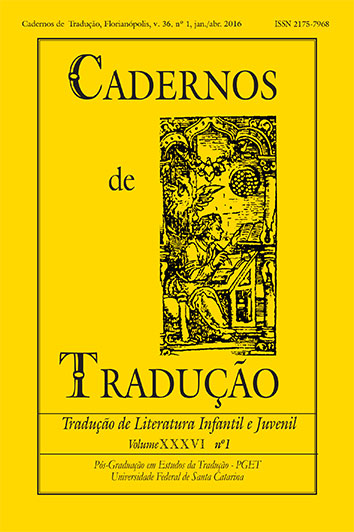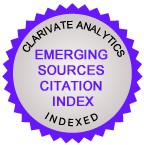“Confucius and unnamed boy”: intertextuality and adaptation
DOI:
https://doi.org/10.5007/2175-7968.2016v36n1p114Abstract
In 2005, Sergio Capparelli met Marcia Schmaltz in a Beijing subway and invited her to co-translate Chinese tales for children and youngsters. This meeting resulted in a collection of over two hundred short stories, which were partially published in 50 Fables of Fabulous China (Capparelli; Schmaltz, 2007) and in Chinese Supernatural Tales (Schmaltz; Capparelli, 2010). In this paper, I present some reflections originated from the bibliographical research about the preparation of those source texts. The first reflection focuses on the influence of the philosophical doctrines of the traditional culture for the Chinese literary production, which has on education one of its main roles. The second one combines literary concepts such as prose fiction, children’s literature and intertextuality in the different cultural systems involved, which must be taken into consideration by the translator. The third one refers to the reconstitution process of the tale “Confucius and unnamed boy”, and to the texts referring to this tale. Finally, the forth reflection is about the translation process. In this part, we discuss the decisions which were made, taking into account the intrinsic aspects of the source texts in the Chinese cultural system for its transposition in the target culture system.
References
BAN, Gu. Han Shu [Anais de Han]. Disponível em: http://ctext.org/han-shu/ens.
BASSNET-MCGUIRE, Susan. Estudos de Tradução. Tradução de Sônia T. Gehring, Letícia V. Abreu e Paula A. R. Antinolfi. Porto Alegre: Editora da UFRGS, 2005.
BRESNER, Lisa. Contes Chinois, Le Bouvier et la Tisserande. Paris: L’école des Loisirs, 2000.
CAPPARELLI, Sérgio; SCHMALTZ, Márcia. 50 Fábulas da China Fabulosa. Porto Alegre: LP&M, 2007.
Cihai. Xangai: Shanghai Cishu, 1999.
Dongyuan Zazi [Enciclopédia Dongyuan]. Disponível em: http://gallica.bnf.fr/ark:/12148/btv1b9006527j/f8.image.langEN
FAIRBANK, John; GOLDMAN, Merle. China: uma nova história. Tradução de Marisa Motta. Porto Alegre: LP&M, 2006.
GONG, Pengcheng. Zhongguo Chuantong Wenhua Shiwu Jiang [Quinze tópicos sobre a cultura tradicional chinesa]. Pequim: Peking University Press, 2006.
GRANET, Marcel. O pensamento chinês. Tradução de César Benjamin. Rio de Janeiro: Contraponto, 1997.
JIANG, Feng; HAN, Jin. Zhongguo Wenxue Shi [História da Literatura Infantil da China]. Hefei: Anhui Jiaoyu Chubanshe, 1998.
LIE, Yukou. Liezi. Disponível em: http://ctext.org/liezi/tang-wen/zhs.
LIMA, Ronaldo; ORGADO, Gisele T.M.R. “Interpretar e traduzir a língua dos Smurfs”, in Cadernos de literatura em tradução, 12, p. 113-124, 2011.
LIU, An. Huainan zi [O príncipe de Huainan]. Disponível em: http://ctext.org/huainanzi/xiu-wu-xun/zhs
LIU, Xiang. Zhan Guo Ce [Estratégias dos Estados Combatentes]. Disponível em: http://ctext.org/zhan-guo-ce/zhs.
LV, Kai. Huainan zi: shenxian daojia [Huainan zi: o daoísta imortal]. Taipei: Shibao wenhua, 1995.
Lunyu [Analectos]. Disponível em: http://ctext.org/analects.
MILTON, John. Translation Studies and Adaptation Studies. In: PYM, Anthony; PEREKRESTENKO, Alexander (eds.) Translation Research Projects 2. Tarragona: Intercultural Studies Group, p. 51-58, 2009.
SCHMALTZ, Márcia. “‘Os três reis’: reflexões a partir de um conto não publicado”. In: Cadernos de literatura em tradução 12, p.173-186, 2011.
______. “A literatura infantil chinesa da poesia à prosa: Uma história sem espaço à criança”. Tigre Albino 2(1), 2008. Disponível em: http://www.tigrealbino.com.br/texto.php?idtitulo=1eb7c72bdf826fe4700f977b9658e5ef&&idvolume=8019c0e24c8199c19b45b5b7170ec4e9
______. “Metáfora conceptual de tempo em fábula chinesa”. Organon 21, p. 35-52, 2007.
SCHMALTZ, Márcia; CAPPARELLI, Sérgio. Contos sobrenaturais chineses. Porto Alegre: L&PM, 2010.
SIMA, Qian. Shiji [Anais da história]. Disponível em: http://ctext.org/shiji/kong-zi-shi-jia/zhs
TIAN, Guixiang; GUO, Bensi. “Zhang Tianyi de jiaohua qingjie” [O enredo moralizante das histórias infantis de Zhang Tianyi]. In: Qilu Xuebao, n.5, p. 103-105, 2007.
WALTY, Ivete. “Intertextualidade”, E-Dicionário de Termos Literários, coord. de Carlos Ceia. Disponível em: http://www.edtl.com.pt.
WANG, Yinglin. Sanzijing [Ode de três caracteres]. Disponível em: http://ctext.org/three-character-classic/zhs
WANG, Zijing. “Handai Qi Lu shentong” [Meninos prodígios de Qi e Lu da dinastia Han]. In Qi Lu Wenhua Yanjiu, disponível em: http://www.qlwh.com/jidi/xinshu.asp?id=612.
XU Zhigang. Lunyu Tongyi [Interpretação de Analectos]. Pequim: Renmin Wenxue Chubanshe, 2003.
ZHANG, Lei (ed.) Zhongguo Gudai Zhexue Dadian [Clássicos da filosofia antiga chinesa]. Wuhan: Editora da Universidade Politécnica de Wuhan, 1989.
ZHOU, Shuren. “Zhongguo xiaoshuo shilue” [História concisa da literatura em prosa da China]. In: Lu Xun Quanji [Obra Completa de Lu Xun]. Pequim: Renmin Chubanshe, v.9, p.147-450, 1973.
Downloads
Published
How to Cite
Issue
Section
License
Copyright (c) 2016 Cadernos de Tradução

This work is licensed under a Creative Commons Attribution 4.0 International License.
Copyright Notice
Authors hold the copyright and grant the journal the right for their articles' first publication, being their works simultaneously licensed under the Creative Commons Attribution License (CC BY), which allows the sharing of such works with its authorship acknowledged and its initial publication in this journal.
Authors are allowed to enter into separate additional contractual arrangements for the non-exclusive distribution of the journal's published version of the work (e.g., post it to an institutional repository or as a book chapter, with an acknowledgment of its initial publication in this journal).






















































